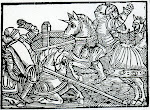As I was going through the vault today, I dredged up a piece of crap I wrote for some hippie femi-Nazi in an American Film History class that I eventually dropped due to nature of films I was being forced to write on (Texas Chainsaw Massacre? Titanic?...nigga please.) In honor of President (gag) Obama, here is some classic B.S. I churned out on race in Night of the Living Dead. Before you read the piece understand that I hate that movie and don't believe a single thing I wrote (for the most part.) It got a solid "A" though.

In film, as in literature, genre pieces are often discounted as commercial devices and seldom examined on their own merits as works of art with any serious application. Arguably, this is most true for the horror film which belongs to a genre which, if taken seriously, must be passed through a sizable sieve in order to separate the myriad of components from the monster films of the Thirties to today’s Japanese new wave and their remakes. The films that would pass the sieve and broach areas worth studying would be those, such as Romero’s Night of the Living Dead (Dead), which carry within them a form of recognizable social commentary. Dead was a product of the Sixties and served to turn an expressionistic lens onto the problems and concerns of that generation.
What is immediately evident in the commentary offered by Romero through his film is the challenging of filmic archetypes with the presence of a sole black male protagonist. Reflected in the protagonist’s struggle are the Civil Rights issues that were exploding on a nation full force during the films production and release in a year, 1968, that saw the assassination of Martin Luther King Jr. It is not difficult to see the resemblance of the final scenes featuring red neck gun-toting militia and their hounds to lynch mobs, leading up to the final and somewhat inevitable execution of the protagonist.
The conflicts of the characters within the film sting with racial commentary as the hero, portrayed by Duane Johnson, refuses to submit to the authority of the “man” and be sequestered into a cellar. Pertinent to the critique of race relations in the film is the manner of death of many of the characters; those who side with Johnson are killed via outside forces i.e. zombies, which could represent society, and those who side against him are killed from within i.e. the family tearing itself apart. Strengthening the commentary of such scenes is the absence of acknowledgement of race by any of the characters involved in the film; each character is accepted on their own terms leaving the audience to be implicated in the race game.
Whereas racial issues of the Sixties color (pun intended) the immediate, it is the Vietnam War and its subsequent social unrest that permeates the entirety of the film. Dead was not the first zombie picture to be made but at its release it was the most violent and graphic of nearly any film to that point prompting a barrage of negativity from critics and movie-goers alike. Many were put off by the gore and explicit images, particularly when the film was bundled with “kiddie pictures” through a gross marketing error by distributor Continental distributing. Yet the film gained and retained popularity because it exposed a violent unrest that defined the late Sixties/early Seventies culture; a culture that saw an easy correlation between the images of the senseless killing on the screen and the war images on the television.
Essentially, Dead is an attempt at modern allegory which seeks to intentionally subvert a volatile culture of inequality and injustice. Whether or not the film succeeds in its critique is a question that could only be answered thirty years ago. The problems that fuel the film have passed and new problems have arisen, many of which have also been dealt with in later Romero films—not least of which being American consumerism. However, during its day, Dead provided a stylized portrait of modern times painted with Romero’s own brand of acerbic insight.






No comments:
Post a Comment